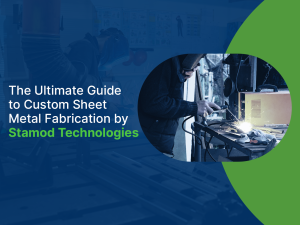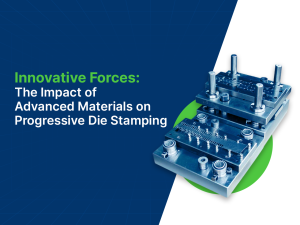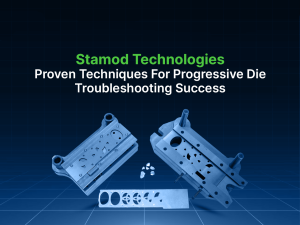Tooling in Injection Molding: Injection molding is one of the most common and widely used manufacturing processes for producing a variety of plastic parts and products. Injection molding involves an injection of molten plastic material into a mold cavity, where it cools and solidifies to get reshaped as the mold. Injection-molded components are a ubiquitous element in nearly every functional product created today, spanning from automotive components to various forms of food packaging.
Tooling in injection molding plays a very crucial role in this process of injection molding, as it determines the quality and precision of the final injected product. Injection molding, an adaptablemolding an adaptable technique, enablestechnique enables the automated production of both simple and intricate components with high-quality results, using materials that have significantly transformed the landscape of manufacturing technology over the past half-century or so.
Stamod Technologies specialises in offering advanced injection molding services, leveraging state-of-the-art technology and a team of highly skilled design professionals. Our goal is to cater to our customers’ unique injection molding needs, ensuring precision and excellence in every project.
Inside the Injection Molding Machine – The cycle that shapes Products
The contemporary injection molding process has evolved significantly, now characterized by the prevalent use of fully automated, closed-loop, microprocessor-controlled machines/control systems. However, at its core, injection molding remains a fundamentally straightforward procedure.
Thermoplastic injection molding begins with the transfer of polymeric material, typically in powder or granule form, from a feed hopper into a heated barrel. Within this barrel, the thermoplastic material undergoes a melting process and is subsequently injected into a mold using a plunger mechanism of some kind. This mold is securely clamped shut, applying pressure through a platen arrangement while being maintained at a temperature below the thermoplastic’s melting point. The molten thermoplastic material quickly solidifies within the mold, allowing for the ejection of the final component following a predetermined cooling period.
7 Essential Tooling in Injection Molding:
7 Essential Tooling in injection molding are listed below:
1. Mold Design
The success in injection molding hinges upon the creation of an effective mold design. This entails the meticulous crafting of a plan encompassing the mold cavity, runner system, and cooling system. During the moldDuring mold designthis process, our designers take into account the various crucial factors like part geometry, material selection, cycle duration, and anticipated production volume.
2. Mold Material
Molds are commonly crafted from premium-grade steel varieties, including P-20, H-13, or stainless steel. The selection of the specific mold material hinges on various considerations, such as the projected production scale and the nature of the plastic material in use. Here at Stamod Technologies, we meticulously assess these injection molding factors to determine the most suitable material for your customised solutions.
3. Runner System
Runner This system is responsible for guiding the molten plastic from the injection unit to the mold cavity. This includes spures, runners and gates. We have a proper well designed and sized runner system which ensures even flow of material and minimises the waste.
4. Cooling System
Effectively managing the cooling process is vital for overseeing the solidification phase and averting issues like warping or sink marks on the end product. The mold design process incorporates cooling channels to proficiently control and maintain the desired temperature. At Stamod Technologies, we pride ourselves on having an exceptional cooling system in place to ensure optimal results.
5. Ejection System
Our ejection system is highly reliable. After the plastic has undergone cooling and solidification, the next step involves extracting it from the mold. This crucial task is accomplished through the use of an ejection system, which comprises elements like ejector pins, sleeves, or plates. These components work in unison to gently and effectively push the finished part out of the mold cavity.
6. Venting
Ensuring adequate venting within the mold is imperative to facilitate the release of air and gases as the injection process unfolds. Our machinery is equipped with proper venting mechanisms to address this requirement effectively. It’s worth noting that insufficient venting can result in defects such as overheating or incomplete filling, underscoring the importance of this aspect in the manufacturing process.
7. Maintenance
Consistent maintenance of injection mold stands as a critical factor for both their durability and sustained performance. Undertaking essential tasks such as cleaning, lubrication, and routine inspections becomes paramount in averting downtime and upholding product quality. At our facility, our dedicated engineers meticulously follow a well-structured Preventive Maintenance (PM) regimen to address these requirements effectively.
The Role of Tooling in Injection Molding for Product Quality
The caliber of tooling directly correlates with the excellence of the end product. Here at Stamod Technologies, our meticulously crafted and well-maintained tooling guarantees:
1. Precision and Consistency
We use the top-notch tooling that yields uniform part dimensions and minimal discrepancies, a pivotal factor in adhering to precise product specifications.
2. Durability
We have exceptional molds that possess the resilience to endure the demands of high-volume production, leading to cost savings by reducing the need for frequent replacements.
3. Shorter Cycle Times
We have optimised tooling that minimises cycle times, resulting in heightened production rates and reduced manufacturing expenses.
4. Reduced Scrap
We have well-structured runner systems and cooling channels that play a pivotal role in diminishing material wastage and defects, consequently lowering the rate of scrap in production.
Tooling Maintenance in Injection Molding: Ensuring Longevity and Quality
In the world of injection molding, tooling maintenance is a fundamental aspect that significantly impacts the longevity of molds and the quality of manufactured products. Tooling, comprising molds and associated components, serves as the backbone of the injection molding process. Stamod Technologies prioritises regular and meticulous maintenance, a critical factor in ensuring the seamless operation of these tools and preventing expensive periods of inactivity. Implementing these practices has yielded fruitful results for us, including an extended lifespan of our systems, consistent product quality, reduced downtime, and enhanced cost-efficiency.
7 Comprehensive Tooling Maintenance Activities at Stamod Technologies
1. Cleaning
In our maintenance routines at Stamod Technologies, we prioritize regular mold cleaning to eliminate any residues, contaminants, or excess materials. This meticulous cleaning procedure is essential to prevent the accumulation that may adversely impact mold performance.
2. Lubrication
As part of our maintenance regimen at Stamod Technologies, we carefully apply appropriate lubricants to moving components and surfaces. This practice is integral to diminishing friction and wear, ultimately ensuring the molds operate smoothly and efficiently.
3. Inspections
We conduct routine inspections to identify wear, damage, or potential issues. Our engineers address any problems promptly to prevent further damage.
4. Corrective Maintenance
At Stamod Technologies, upon identifying any issues during inspections, we take immediate action by implementing corrective maintenance measures, such as conducting repairs or replacing components as necessary to ensure optimal performance.
5. Preventive Maintenance
We have established a proactive preventive maintenance schedule that encompasses essential tasks such as cleaning, lubrication, and inspections. We adhere to this schedule diligently, ensuring that molds receive regular servicing, even if they seem to be in good working order.
6. Temperature Control
At Stamod Technologies, we prioritize the maintenance of precise temperature control throughout the injection molding process. This commitment stems from our understanding that temperature fluctuations can subject molds to thermal stress, potentially resulting in premature wear and reduced longevity.
7. Operator Training
At Stamod Technologies, we place a strong emphasis on training our machine operators and maintenance personnel in the correct handling and maintenance techniques for tooling. This dedication to training ensures both consistency and effectiveness in our operations.
In the world of injection molding, tooling is the unsung hero that determines the success of manufacturing operations. From mold design and construction to mold maintenance and material selection, every aspect of tooling plays a vital role in producing high-quality products. As technology advances, innovations in tooling continue to enhance the efficiency and precision of the injection molding process, opening up new possibilities for manufacturing industries worldwide.
Stamod Technologies, driven by an unwavering commitment to excellence, stands at the forefront of delivering cutting-edge injection molding solutions tailored to our clients’ unique needs and aspirations. Our seasoned team of engineers and technicians boasts profound expertise across every dimension of the injection molding domain. Supported by a state-of-the-art facility equipped with the latest machinery and technology, we proudly offer unparalleled injection molding services that consistently surpass expectations. We empower your product’s triumph through our Injection Mold Design service.

Engineering
Manufacturing
Prototyping
Software Development
AI for Manufacturing
Engineering
Manufacturing
Prototyping
Software Development
AI for Manufacturing








